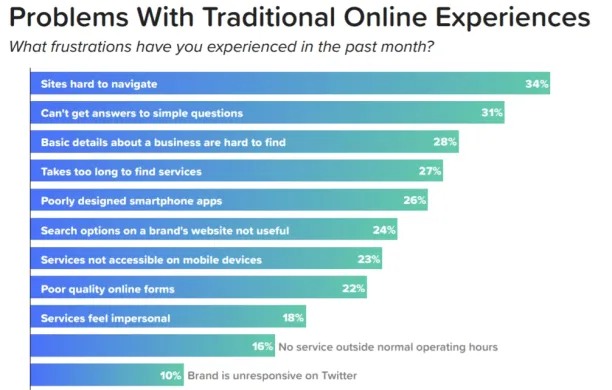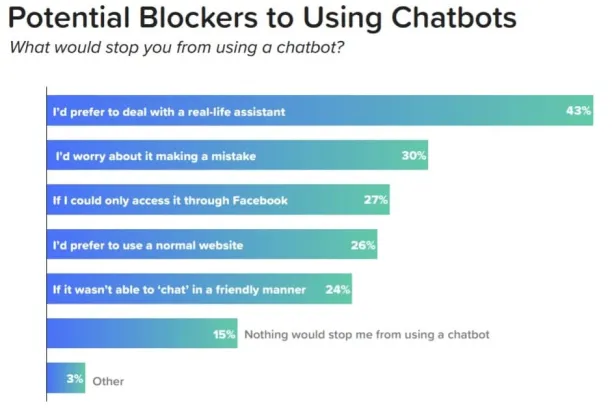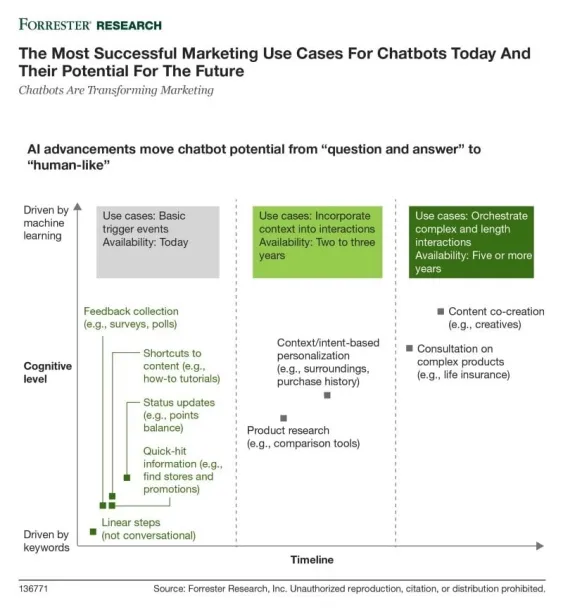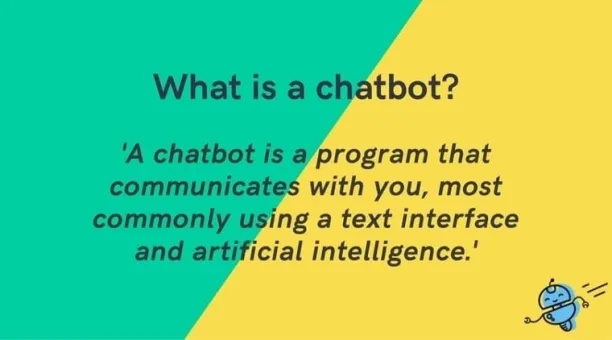Chatbots in 2024: Benefits, Applications & Best Practices
Around 80% of business executives want to change the way they deal with customer relations by adopting chatbots. In this article, we offer a complete guide regarding chatbots to help executives to better understand:
- Definition of chatbots.
- Importance and benefits of chatbots.
- Their main application areas.
- Challenges you may face.
- Best practices to overcome challenges and more.
What is a chatbot?
A chatbot is a computer program that enables people to get information from machines in a natural, conversational, way using text and voice
There are two major channels in which chatbots are implemented. One of them is text-based channels, such as Whatsapp, Messenger, Slack, and Telegram. The other channel is voice-based virtual assistants such as Alexa, Siri, and Cortana.
Feel free to check our list of top 20 use areas of chatbots.
Chatbots will bring more savings and efficiency
Chatbots provide savings thanks to automation that reach up to 60% for some industries. One of the best ways for reducing cost by using chatbots is deploying them for answering frequently asked questions by the clients. By doing so you can automate over 70% of your call service workload and augment your employees.

Chatbots solve important customer problems
According to McKinsey, for customers, the most crucial factors for successful customer engagement are reaching the desired outcome, speed, and ease of experience.
Chatbots offer a lot for businesses in this perspective because:
- They can work 7/24.
- They can perform multiple tasks.
- They can serve in many languages.
They are deployed on digital platforms like custom mobile apps which provide easy access for customers.

Messaging apps are the right medium to implement chatbots
The widespread availability of messaging apps makes it a great target for potential expansion. Latest figures for monthly active users of messaging apps are over 5 billion. Platforms like Whatsapp, Facebook Messenger, WeChat, and Telegram have already made it possible to implement chatbots.
This makes reaching out to, and communicating with, customers on multiple platforms a reality. Think about salespersons for instance: they can only communicate with one-person at a time. Chatbots provide a huge scalability with a potential of communicating with millions of people at the same time all through messaging apps.
Chatbot use cases for your business
Chatbots have numerous possible benefits in diverse areas:
- Marketing: Messaging has a larger social base than all other areas of social media. Brands have been experimenting heavily with chatbots since the launch of Facebook Messenger Platform and discovered numerous use cases engaging their customers daily. We compiled all chatbot applications brands can build.
- Customer service: Customer service wages in the US is $100+ Billion p.a. Even small savings in wages can create massive benefits for B2C enterprises where customer reps spend a significant portion of their time answering simple questions.
- Inside sales: Conversion rate is 10x more for leads that are contacted within 5 minutes according to an insidesales.com study. Achieving that with a human team takes a large team and low utilization. Bots can achieve such speeds at low cost.
- Healthcare: Chatbots have significant potential in healthcare but regulatory challenges are likely to delay their adoption
- Prescription reminders: Bots like Florence provide reminders for prescriptions set by patients. This could be quite a suitable service for hospitals or pharmacies.
- Diagnostic-aid: Users tell Baidu Melody about their symptoms after which Melody asks several questions to produce a preliminary diagnostic.
- Therapy: There are already numerous chatbot companies such as X2AI, Therachat or Woebot helping people manage their mental health.
To learn more about the various use cases of chatbots, click here.
Risks of launching your business’ chatbot
Chatbots have significant potential but that does not make them easy to implement. We explained in our detailed blog post on chatbot failure how discoverability, customer expectations and technological limitations have limited traction for numerous bots. Unfortunately, customers are quite sensitive to chatbot failures. And, chatbots fail so frequently that we already have a section on chatbot failures.

Mitigate your chatbot’s risks in 3 simple steps
For most large businesses, the benefits of launching your bot outweighs its risks, especially if best practices regarding chatbot development and testing are followed.
Most chatbots’ dysfunctionalities can be avoided by following these 3 steps:
- Extensive testing: There are so many bot testing tools that we have a dedicated article on chatbot testing frameworks and another on chatbot A/B testing.
- A private beta release: Your team needs to eat its own dog food before the public has access to it.
- Using a custom language matrix: Chatbot developers build a language corpus along with PR and marketing to ensure that bot’s messages are consistent with company’s messages. This ensures that the bot has a consistent personality and shares consistent messages. While restricting bots’ conversational capabilities, this limitation provides peace of mind to executives in major corporations that are releasing their bots into the wild.
Turn your chatbot into a success with 3 tips
- Make your chatbot easy to discover. You know the channels where your customers are reaching out to you. Your bot needs to be on the most popular channels: your website, Facebook page and so on.
- Lower your customer’s expectations as much as possible. Your chatbot won’t be flawless from day one. So if you are in the early stages of adoption, make sure you let your customers know that the chatbot they’re interacting with is still in its infancy and can make mistakes.
- If your chatbot is designed to function like a menu, don’t shy from adding buttons. No one likes to write 10 lines to trigger a simple transaction.
For more, discover how to build great chatbots in our detailed chatbot best practices article.
Should you implement a chatbot?
After analyzing the enhancements and advantages of chatbots, you should decide whether or not you really need to implement a chatbot.
The following checklist can help you realize whether implementation is right for you:
- Decide on the value you are expected to gain by implementing a chatbot. The value proposition is a major factor in deciding on any project. So before this decision, performance metrics need to be defined and the cost of implementing the project and the benefit expected from the project should be included also.
- The medium the chatbot implemented is another factor. Will it be voice-based or text-based? What would be the connection between the consumer and the bot? Those are some of the basic questions. Chatbot is expected to reflect the brand’s personality, but will it be possible to construct that so as to continue seamless brand experience.
- What is the available data? The decision will ultimately come down to deciding which resources to use and once the decision is made, it takes some time to train the chatbot. If there exists some data of the desired characteristics, initial stages may be completed more easily otherwise the process requires a brand new collection method, making the initial steps to last longer.
What is the future of chatbots?
Forrester research provides us a timeline of chatbot technology. Currently, we are still experiencing the initial stages. Therefore, any investment in a chatbot will likely generate a greater return thanks to first-mover’s advantage. Compounding is still the keyword for early adaptation. The potential to fully personalize the experience still requires some time, but we are likely to reach that point in 5 years.

Another future development that holds promise is chatbots interacting with one another. Like APIs, chatbots can request services from one another and communicate seamlessly, without even needing to expose formal APIs. Such fluid exchange between bots can enable a wide range of services.
For example a Google for chatbots with advanced natural language understanding skills can not only answer any question, it can also complete any transaction given that you have the means to complete it. While a pure web based meta service like Google can return information, it can not do anything on your behalf on other websites unless they have an API integration. However, a chatbot programmer only needs to make his bot better understand natural language and that bot will be able to serve both humans and bots effectively.
How to learn more?
Hope you are more clear about what chatbots are and their promise. You can choose your area of interest to learn more:
- major chatbot failures
- top chatbots
- examples of how chatbots really add value to businesses.
- chatbot guides for different uses in different sectors.
Are you looking for a conversational AI vendor? Let us know:

Cem has been the principal analyst at AIMultiple since 2017. AIMultiple informs hundreds of thousands of businesses (as per similarWeb) including 60% of Fortune 500 every month.
Cem's work has been cited by leading global publications including Business Insider, Forbes, Washington Post, global firms like Deloitte, HPE, NGOs like World Economic Forum and supranational organizations like European Commission. You can see more reputable companies and media that referenced AIMultiple.
Throughout his career, Cem served as a tech consultant, tech buyer and tech entrepreneur. He advised businesses on their enterprise software, automation, cloud, AI / ML and other technology related decisions at McKinsey & Company and Altman Solon for more than a decade. He also published a McKinsey report on digitalization.
He led technology strategy and procurement of a telco while reporting to the CEO. He has also led commercial growth of deep tech company Hypatos that reached a 7 digit annual recurring revenue and a 9 digit valuation from 0 within 2 years. Cem's work in Hypatos was covered by leading technology publications like TechCrunch and Business Insider.
Cem regularly speaks at international technology conferences. He graduated from Bogazici University as a computer engineer and holds an MBA from Columbia Business School.
To stay up-to-date on B2B tech & accelerate your enterprise:
Follow onNext to Read
Top 10 Business Processes an RPA Chatbot Automates in 2024
Top 14 Chatbot Benefits For Companies & Customers in 2024
30+ Chatbot Use Cases/Applications in Business ('24 Update)
Hi Cem! Thank you so much for all of this information – do you have any data you could share on 3D avatars and whether or not they hurt or enhance the effectiveness of an ai chatbot?
Hello, Lauren! Thank you for your feedback. In our next update, we will look into 3D avatars-chatbot integration and add it to the article if we find enough facts about it.
I love your content very much. Always new.
Thanks! Sorry for removing the link, if we don’t remove them, we get too many comments.


![Top 4 Chatbot Ecosystem Maps Compared [2024 Update]](https://research.aimultiple.com/wp-content/uploads/2017/08/Chatbot-v0.3-scaled-190x165.jpg.webp)
Comments
Your email address will not be published. All fields are required.